Learn how to make perfect sushi rice so you can dish up your favorite sushi rolls at home! In this recipe, I’ll share my secrets for how to cook the rice and season it well for delicious, mouth-watering results every time.

Perfectly cooked and seasoned rice for sushi (酢飯) is fundamental to the best sushi, and the top restaurants in Japan pride themselves on the excellence of their vinegar-flavored rice. You can learn How to Make Sushi Rice at home, too, with the secrets and techniques I share in this recipe. Follow along and I’ll teach you how to prepare perfect seasoned rice every time to use in your homemade sushi rolls and other creations!
If you love sushi, try my Dragon Roll, Inari Sushi, and Temaki Sushi (Hand Roll) recipes next!
What is Sushi Rice?
In ancient Japan, the rice in sushi was actually a fermentation agent used with salt to preserve fish for months. Called narezushi, the fish was consumed and the rice was tossed. The preparation time shortened drastically over the decades and the rice started to be served along with the fish. Vinegar eventually replaced fermentation to mimic the pleasant sour taste that people came to expect from this dish. Sushi evolved again in the 1600s to use vinegared rice and fresh fish in what became known as hayazushi or “fast sushi.”
These days, we enjoy seasoned sushi rice with this same signature sour flavor. Called shari (シャリ), sushi-meshi (鮨飯), or su-meshi (酢飯) in Japan, sushi rice is now enjoyed around the world as the foundation of many modern Japanese sushi styles. These range from cut rolls to ball-shaped treasures, from pressed to scattered, and from hand-shaped nigiri at the finest restaurants to everyday sushi rice wrapped in fried tofu pouches.
Table of Contents
Why I Love This Recipe
- Shiny, plump, and well-seasoned rice every time!
- Uses the golden ratio for the perfect texture – I’ll teach you the perfect ratio of rice-to-water to use when cooking so your rice is slightly sticky with the right firmness. No more soft and mushy rice!
- A simple and easy homemade sushi vinegar – It takes just a few minutes and only three pantry ingredients to make the sweet, salty, and tart rice seasoning.
- Make the right amount of sushi rice – I provide two different options below so you can make the right amount of rice that you need for your sushi recipe.

Ingredients for Sushi Rice
- Japanese short-grain white rice
- Kombu (dried kelp) – optional
- Sushi vinegar:
- Japanese rice vinegar (unseasoned)
- Sugar
- Salt
Find the printable recipe with measurements below.
Jump to RecipeSubstitutions
- Japanese short-grain white rice – You can substitute Japanese rice with Korean rice, as they are pretty similar. Both are short-grain Japonica rice cultivars with the same natural sticky texture once cooked. The main difference is where the rice is cultivated.
- Kombu (dried kelp) – While optional, adding kombu when cooking your rice will infuse it with a nice aroma and hint of umami. You can skip it if you don’t have any on hand.
- Japanese rice vinegar – I always make homemade sushi vinegar with unseasoned rice vinegar, sugar, and salt. It doesn’t take long! For convenience, you can certainly use a bottle of seasoned rice vinegar called sushizu (すし酢).
Key Kitchen Tools

- Hangiri (sushi oke) – This wide and flat wooden tub is the traditional vessel for seasoning the rice. It’s the ideal shape to spread out the hot rice and cool it after adding the sushi seasoning, and the hinoki (cypress) absorbs excess moisture. If you don’t have a hangiri, I suggest using a moistened large baking sheet or salad bowl.
- Fan – I use a traditional handheld paddle fan (uchiwa) to cool the rice, or you can use an electric fan.
- Rice paddle – The flat and broad shape lets you “slice” through the rice clumps when adding the sushi vinegar.
- Rice cooker – I use a rice cooker (this is my favorite), but you can certainly cook your rice in a pot on the stove, Instant Pot, or donabe (I have recipes for all these methods on this website). Since we use less water for cooking rice for sushi compared to regular steamed rice, please note that the cooking time will be slightly shorter.

How to Make Sushi Rice
Preparation
Step 1 – Wash and soak the rice. Wash and rinse away the impurities and starch on the rice a few times until the water runs clear. Drain it well and add it to your rice cooker pot. Add the measured water and top it with a piece of kombu. Let the rice soak for 20–30 minutes.

Cooking
Step 2 – Start cooking the rice and make the vinegar mixture. Select the Sushi program if your rice cooker has one, close the lid, and press Start. Meanwhile, combine the rice vinegar, sugar, and salt in a small saucepan on the stovetop. Whisk over medium-high heat and bring it to a near boil. Set aside to let it cool. See my instructions below for how to use the microwave for this step.

Step 3 – Remove the kombu from the cooked rice. When the rice is done steaming, transfer all of it to the sushi oke (or baking sheet). Spread it out evenly so it will cool faster.
Assemble
Step 4 – Add the cooled sushi vinegar onto the hot rice. I pour the seasoning onto my rice paddle to better control the flow.

Step 5 – “Slice” the rice to distribute the seasoning while cooling it. Hold the rice paddle at a 45-degree angle. Vigorously fan the rice while you “slice” the rice chunks to separate them and distribute the sushi vinegar. Use a folding motion to flip over the rice in between slices. Repeat until cooled to the temperature of human skin.

Step 6 – Cover with a damp cloth. Your sushi rice is ready to use. Keep it covered with a damp towel (or paper towel) at room temperature for up to a few hours. This will help absorb any evaporating moisture and keep the rice from drying out.
Step 7 – Use the sushi rice for your favorite sushi recipe.
Nami’s Recipe Tips
- Use Japanese short-grain white rice. With a higher moisture content than other varieties, Japanese rice has the slight stickiness and signature firm texture you want for sushi. I strongly discourage using long-grain rice, jasmine rice, brown rice, or other varieties, as your sushi will fall apart.
- Measure the cooking water precisely. To achieve the perfect texture, we need to cook rice for sushi a bit firmer than regular table rice. Use exactly a 1-to-1 ratio of rice to water by volume to allow for the additional moisture the cooked rice will absorb from the sushi vinegar. If you use the regular 1 to 1.1 (or 1.2) ratio for standard rice, I guarantee that it will turn out soft and mushy!
- Soak the rice before cooking. Japanese rice needs to soak before cooking so the water can start to penetrate the round, plump grains. I know it’s tempting to skip this step, but it’s crucial to soak the rice for 20–30 minutes so it cooks properly. Depending on your rice cooker brand, the cooking program may include 10 minutes of soaking time.
- Cook the rice with kombu. Although optional, kombu (dried kelp) imparts a subtle aroma and umami taste that I just love. I highly recommend it! My favorite type to use for this is rishiri kombu.
- Use Japanese rice vinegar. For an authentic taste, you must use mild-flavored Japanese rice vinegar to season rice for sushi. I don’t recommend using another type, as the flavor will be too strong.
- Add the sushi vinegar while the rice is hot. Season the steaming hot rice with sushi vinegar as soon as you take it out of the rice cooker. Cooled rice will not absorb the seasoning well.
- Use a slicing motion with a rice paddle. Insert the flat and wide rice paddle into the rice at a 45-degree angle and use a cutting motion to distribute the sushi vinegar while separating the clumps. If you use a stirring or mixing motion, the rice will end up mushy and smashed.
- Cool the rice quickly. To prevent mushy and dull sushi rice, cool the hot rice quickly while you season it. I recommend using a large and wide vessel like a sushi oke (hangiri) to help release the steam and evaporate the moisture. Use one hand to distribute the sushi vinegar with the rice paddle and use your other hand to fan the rice to cool it. This wicks away moisture, which make the rice shine. I use a handheld paddle fan called uchiwa (うちわ); you can also use an electric fan.
Different Ways to Use Sushi Rice
You can use your freshly made sushi rice in different ways in your daily meals, at potlucks and picnics, and for special occasions. I put together this quick list of the many types of dishes that you can create with your perfect homemade sushi rice! Most of these recipes are vegan/vegetarian adaptable, too.
- Thick, medium, and thin sushi rolls – Called maki sushi in Japanese, these include colorful thick Futomaki with many fillings, medium (chumaki) Spicy Tuna Rolls, or thin Sushi Rolls (hosomaki) with one filling.
- Inside-out sushi rolls – Uramaki is a type of maki sushi with sushi rice on the outside and a nori sheet on the inside. California Roll is an inside-out variety that’s by far the most popular sushi roll in the US.
- Nigiri sushi – Perhaps the most popular sushi that’s served in sushi bars and restaurants around the world, these individual bite-size pieces of sushi rice are typically topped with sashimi-grade fish.
- Scattered sushi – We serve festive Chirashi Sushi on happy and celebratory occasions. A modern version is beautiful Chirashi Sushi Cake that you can slice up for birthday parties and Girls’ Day (Hinamatsuri). Chakinzushi and cup sushi are ways to serve scattered sushi.
- Sushi wrapped in fried tofu pouch – Comforting and tasty Inari Sushi is so easy to prepare for a snack or party.
- DIY hand rolls – Each guest can customize their own cone-shaped roll with Temaki Sushi.
- Ball-shaped sushi – Temari Sushi are some of the prettiest sushi you can make!
- Pressed sushi – The most popular variety of this traditional layered and compressed sushi is Mackerel Pressed Sushi.
- Checkerboard sushi – A type of pressed sushi, my modern Mosaic Sushi is a feast for the senses!
Storage and Reheating Tips
To store: To keep your leftover sushi rice fresh and moist, transfer it to an airtight container and store it in the freezer. Do not refrigerate it.
To reheat: Bring the frozen rice back to room temperature when you need it to make sushi!
Frequently Asked Questions
I strongly discourage using long-grain rice, jasmine rice, brown rice, or glutinous sticky rice, as your sushi will fall apart. Japanese short-grain white rice has a higher moisture content than other varieties, so it has the slight stickiness and signature texture that you want.
Please check the type of rice you used. You may have cooked the wrong type of rice. The only rice I recommend for sushi is Japanese short-grain white rice. That’s because it has a higher moisture content than other varieties and a slight stickiness and firmness that you need for the rice to stick together for sushi.
Brown short-grain rice does not have a sticky texture and will be difficult to work with when making sushi, particularly nigiri sushi or sushi rolls. Brown rice tends to be denser and can sometimes crumble, and the higher content of fiber and earthy flavor makes it less ideal for making delicious sushi.
You may reduce the amount of sugar, if you prefer. However, sugar is important to counterbalance the tartness of the rice vinegar. If you want to reduce the sweetness, I recommend that you add less sugar to start, taste the sushi vinegar, and add more until the balance is to your preference.
You may reduce or skip the salt if you prefer, but it may throw off the balance of flavors in your sushi rice. I always recommend adding a bit of salt to accentuate the seasoning’s sweetness.
I don’t recommend it, since the flavor will likely be too strong compared to Japanese rice vinegar, which is quite mild and creates an authentic taste.
More Sushi Recipes
If you love this sushi rice recipe, you’re in for a treat with these irresistible sushi recipes.
How to Make Sushi Rice (for Sushi Recipes)
Video
Ingredients
★ For 3–4 Servings (Makes 4 Medium Sushi Rolls)
- 1½ cups uncooked Japanese short-grain white rice (2 rice cooker cups; 360 ml; yields 4⅓ cups or 660 g of cooked rice)
- 1½ cups water (360 ml)
- 1 piece kombu (dried kelp) (5 g per piece; 2 x 2 inches, 5 x 5 cm; optional, for a nice aroma!)
- 4 Tbsp rice vinegar (unseasoned) (or use the same amount of bottled, pre-seasoned sushi vinegar and skip the sugar and salt)
- 2 Tbsp sugar (skip if using bottled sushi vinegar)
- 1 tsp Diamond Crystal kosher salt (skip if using bottled sushi vinegar)
★ For 5–6 Servings (Makes 6 Medium Sushi Rolls)
- 2¼ cups uncooked Japanese short-grain white rice (3 rice cooker cups; 540 ml; yields 6⅔ cups or 990 g of cooked rice)
- 2¼ cups water (540 ml)
- 1 piece kombu (dried kelp) (5 g per piece; 2 x 2 inches, 5 x 5 cm; optional, for a nice aroma!)
- ⅓ cup rice vinegar (unseasoned) (or use the same amount of bottled, pre-seasoned sushi vinegar and skip the sugar and salt)
- 3 Tbsp sugar (skip if using bottled sushi vinegar)
- 1½ tsp Diamond Crystal kosher salt (skip if using bottled sushi vinegar)
Instructions
Before You Start…
- DO NOT use scaling (x 2 or x 3) for this recipe.
- How much rice to cook depends on the kind of sushi you make. One thick sushi roll (futomaki) requires 1⅔ cups (250 g) of sushi rice. One medium sushi roll (chumaki) like Vegetarian Sushi Roll requires 1 cup (150 g) of sushi rice. One thin sushi roll (hosomaki) requires ½ cup (80 g) of sushi rice. One inside-out sushi roll (uramaki) like California Roll requires ¾ cup (110 g) sushi rice. One nigiri sushi requires 20 g of sushi rice.
- How to Measure Rice: Overfill a ¾ cup measuring cup or a plastic rice cooker cup with uncooked short-grain white rice and level it off. Put the measured rice in a large bowl. Repeat until you have the amount you need. Tip: You must use Japanese short-grain white rice or your sushi will fall apart.

- Now, gather all the ingredients.

To Wash the Rice
- Quick Rinse: Add just enough water to the bowl to submerge the rice, then pour off the water immediately. Tip: Rice absorbs water very quickly when you start rinsing, so discarding this water right away helps rinse off impurities while keeping the rice from absorbing the first few rounds of milky water.
- Wash: With your fingers, gently agitate the wet grains in a circular motion for 10–15 seconds. Tip: Using very little water allows the grains to rub against each other and reduces the absorption of impurities.

- Rinse: Add water and immediately discard the cloudy water. Repeat Wash and rinse (steps 2 and 3) two more times.

- Drain: When the water is almost clear, drain the rice thoroughly. Tip: Use a fine-mesh sieve to drain and shake off any excess water.
To Soak and Cook the Rice
- Put the well-drained rice in the inner pot of a rice cooker and add the measured amount of water. If your rice cooker has a Sushi Rice mode, add water up to the line for how many rice cooker cups of rice you're cooking. If not, use the White Rice mode and add water to just under that line. Tip: Use 1 part rice to 1 part water for sushi rice—less liquid than for regular steamed rice—to account for absorbing the seasoned sushi vinegar later.
- Check the piece of kombu for dirt particles. If you see any, use a damp cloth to gently wipe them off (this is the traditional method, but kombu is fairly clean these days). Do not wipe off the white powdery substance that contributes to the umami flavor, and NEVER wash kombu! Now, place the kombu on top of the rice in the pot.
- Let the rice soak in the water for 20–30 minutes, then start cooking. If you don‘t have a rice cooker, cook the rice in a pot over the stove, Instant Pot, or donabe with the same amount of water I specified in this recipe.
To Make the Homemade Sushi Vinegar (Optional)
- If you are not using store-bought sushi vinegar (seasoned rice vinegar), follow this step. Combine the rice vinegar, sugar, and salt in a small saucepan.
- Heat it over medium-high heat until it's nearly simmering, whisking until the sugar is dissolved. Alternatively, you can heat the ingredients in a microwave-safe bowl for 1 minute or until the sugar dissolves. Set aside to let it cool.
To Season the Rice
- Moisten a wooden sushi oke (called hangiri) with running water, drain, and dry it with a clean towel. You can also use a large salad bowl or baking sheet lined with parchment paper. Tip: This wooden tub helps absorb excess moisture whereas a ceramic bowl cannot.
- When the rice is done cooking, discard the used kombu (or repurpose it to make simmered kombu).
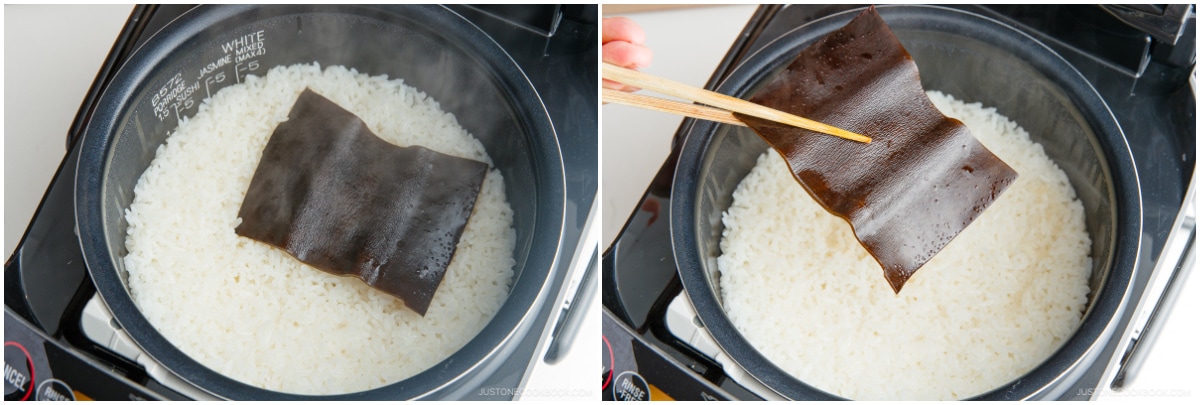
- Transfer the hot cooked rice to the sushi oke. Spread out the rice evenly so it will cool faster.
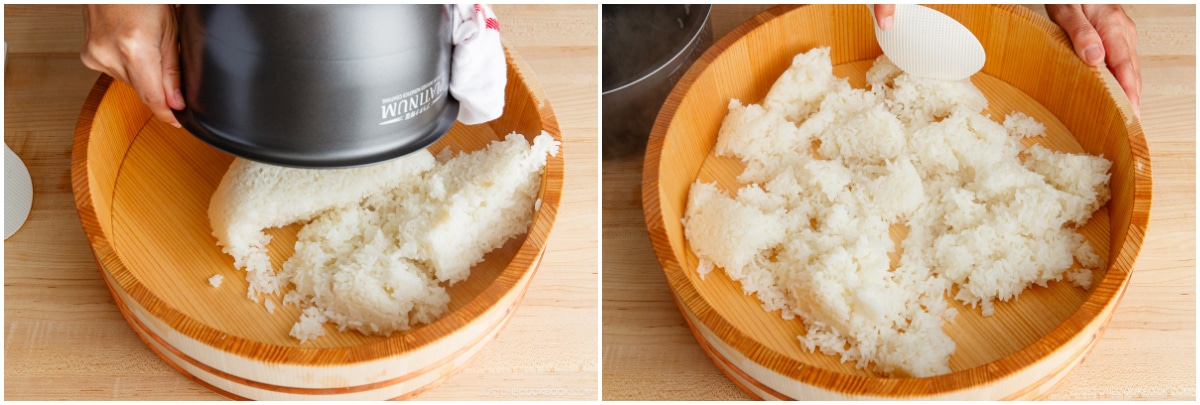
- While the rice is hot, pour the sushi vinegar over it.
- With a rice paddle, gently “slice” the rice at a 45-degree angle to incorporate the vinegar mixture and separate the rice chunks. Do not use a stirring or mixing motion because the grains may break and make the rice mushy. At the same time, vigorously fan the rice with a paddle fan or another type of fan to cool it. Fanning wicks away the excess moisture and makes the rice shine.

- Gently flip the rice after every few slices.
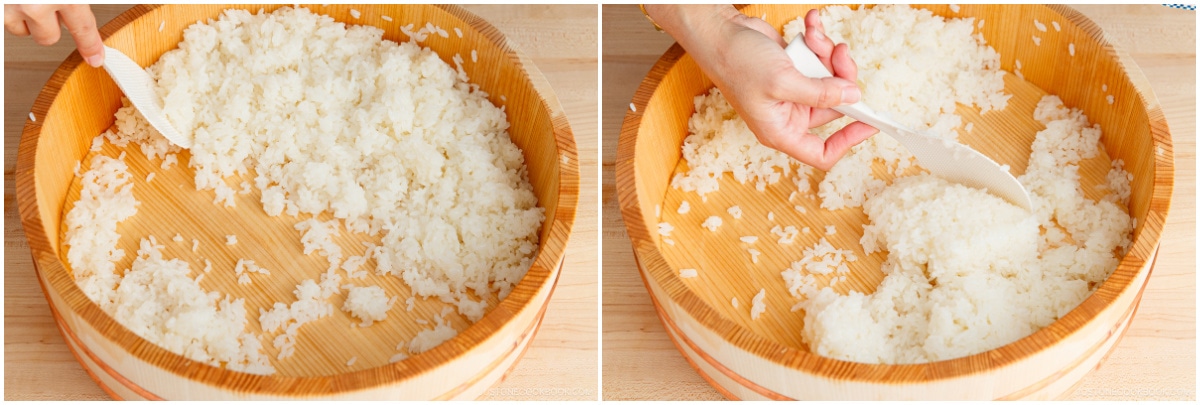
- Repeat this process until the rice is cooled to the temperature of human skin. Your sushi rice is now ready to use in your favorite sushi recipes.
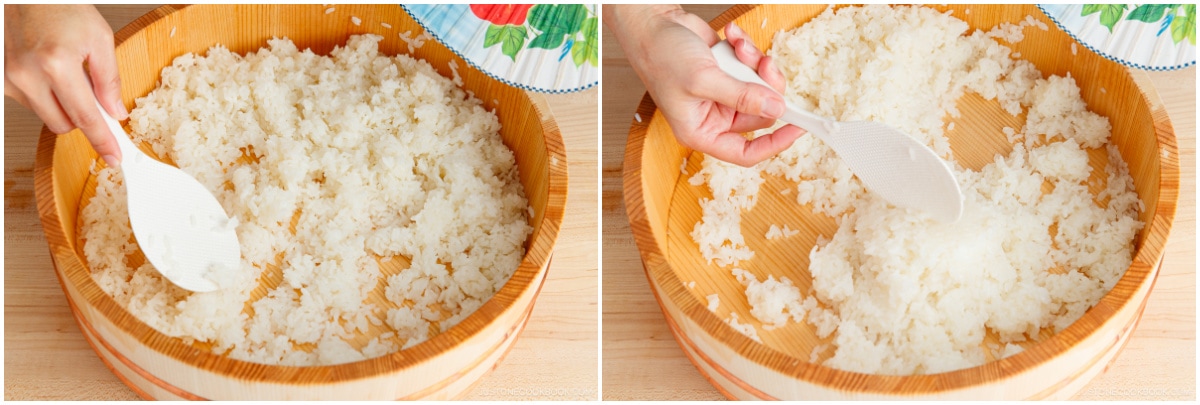
To Keep
- Cover the sushi rice with a damp towel (or paper towel) and keep it at room temperature for up to a few hours. To store it longer, see below.
To Store
- Rice gets hard and dry in the refrigerator from the cold air. Therefore, I recommend freezing the leftover sushi rice in an airtight container for up to a month. When you're ready to use it, defrost the frozen rice overnight in the fridge, then bring it to room temperature (not hot) in the microwave. If you really want to refrigerate it, cover the container with a thick kitchen towel, so the rice will stay cool but not become cold.
Notes
 How much rice do you need to make?
How much rice do you need to make?
- 1 rice cooker cup (180 ml, ¾ cup, 150 g) of uncooked rice makes 2¼ cups (330 g) of cooked rice.
- 1 thick sushi rolls
- 2 medium sushi rolls
- 4 thin sushi rolls
- 3 inside-out rolls
- 2 rice cooker cups (360 ml, 1½ cups, 300 g) of uncooked rice make 4⅓ cups (660 g) of cooked rice.
- 2 thick sushi rolls
- 4 medium sushi rolls
- 8 thin sushi rolls
- 6 inside-out sushi rolls
- 3 rice cooker cups (540 ml, 2¼ cups, 450 g) of uncooked rice make 6⅔ cups (990 g) of cooked rice.
- 4 thick sushi rolls
- 6 medium sushi rolls
- 12 thin sushi rolls
- 9 inside-out sushi rolls
- 4 rice cooker cups (720 ml, 3 cups, 600 g) of uncooked rice make 8¾ cups (1320 g) of cooked rice.
- 5 thick sushi rolls
- 8 medium sushi rolls
- 16 thin sushi rolls
- 12 inside-out sushi rolls
- 5 rice cooker cups (900 ml, 3¾ cups, 750 g) of uncooked rice make 11 cups (1650 g) of cooked rice.
- 6 thick sushi rolls
- 11 medium sushi rolls
- 20 thin sushi rolls
- 15 inside-out sushi rolls
 How many cups of (prepared) sushi rice do you need?
How many cups of (prepared) sushi rice do you need?
- One thick sushi roll (Futomaki) requires 1⅔ cups (250 g) of sushi rice.
- One medium sushi roll (Chumaki), like Vegetarian Sushi Roll, requires 1 cup (150 g) of sushi rice.
- One thin sushi roll (Hosomaki) requires ½ cup (80 g) of sushi rice.
- One inside-out sushi roll (Uramaki), like California Roll, requires ¾ cup (110 g) of sushi rice.
- One nigiri sushi requires 20 g of sushi rice.
Nutrition
Editor’s Note: This post was originally published on Aug 18, 2011 and updated with new images and video on January 19, 2024. It was republished with more helpful content on December 8, 2024.
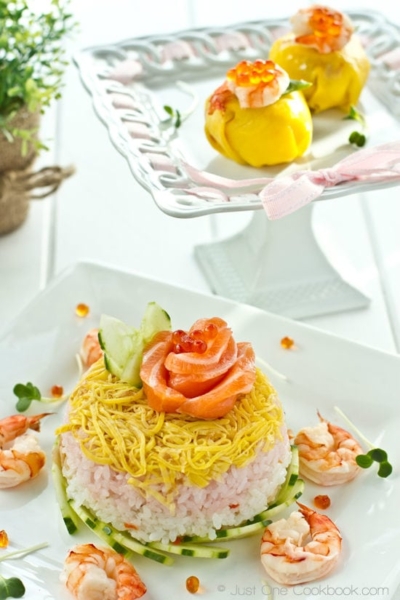
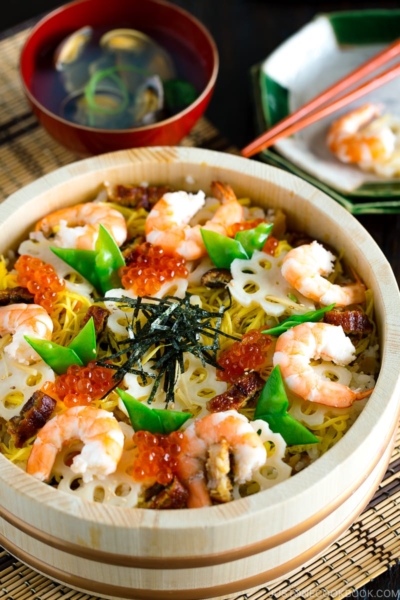
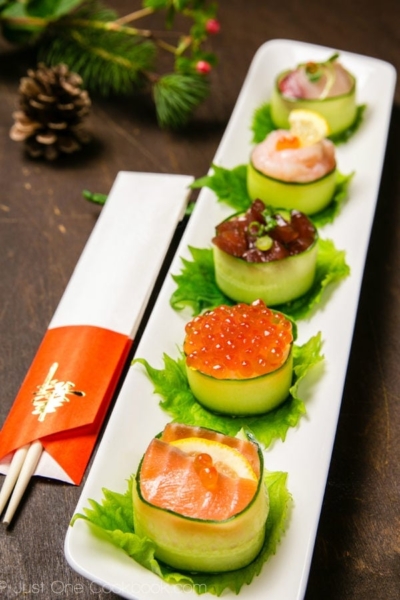




can you reccomend what to look for in a good hangiri? Thank you!
Hi, Nicholas! Thanks for reading Nami’s post.
The high-quality one is made from Sawara Cypress wood. We hope this helped!
Hi, I made the rice per the instruction but rice was too sweet and not sticking together very well. I made 3 rice cooker cups
Hello, Doris, Thank you for trying Nami’s recipe! Could you let me know what type of rice you used?
If it’s not Japanese short-grain rice, the sushi may not turn out properly.
Here’s some additional information regarding rice types that I hope will help!
https://www.justonecookbook.com/premium-japanese-short-grain-rice/
I weighed a 5x5cm (2×2″) kombu piece and it’s nowhere near 5g. It was about 1.2g. Should I still measure it by size?
Hi, Eti! Thank you for trying Nami’s recipe.
Most likely, your Kombu is quite thin. You can add one more piece if you’d prefer additional Umami. Hope this helps! 🙂
Hello all,
I was curious about the type of Kombu that is used in this recipe (Rausu, Hidaka, Rishiri or MaKombu)
Hello, Stefan! Thank you for trying Nami’s recipe.
Rishiri would be an excellent choice for sushi rice. This post provides further information about all the different flavors of Kombu.
https://www.justonecookbook.com/kombu/
We hope this helps!
Just made a wonderful Valentine’s Day dinner for my sweetie. Fatty tuna sashimi with a slaw salad and your miso dressing and the best sushi rice thanks to your excellent guidance,
Hi Cleisha! Wow! Thank you for sharing the photo with us. It looks delicious!
Thank you for using Nami’s recipes.🤗